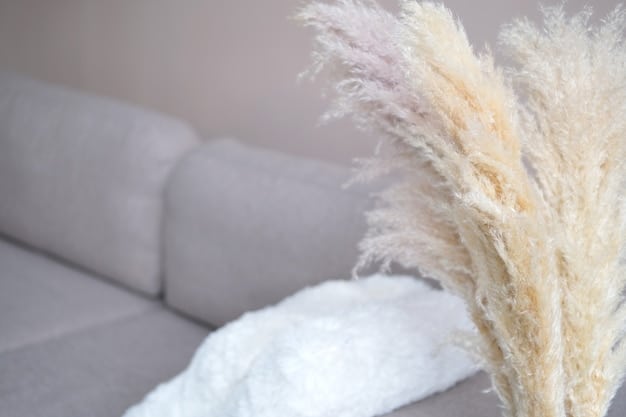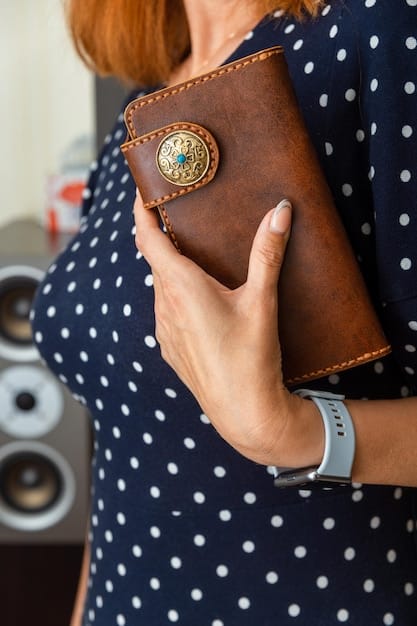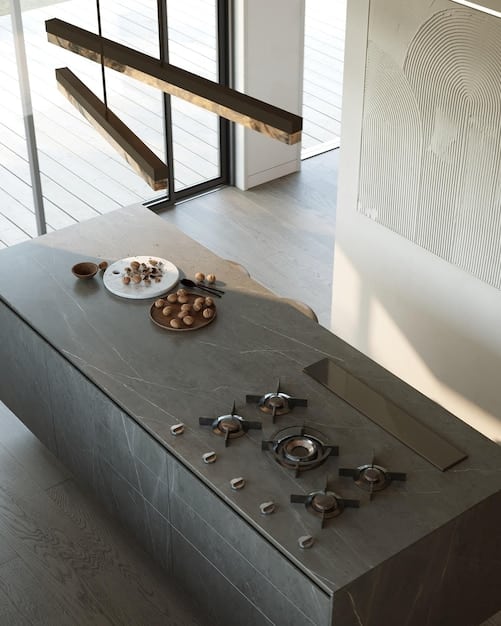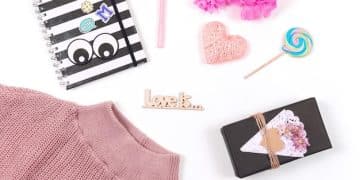Quiet Luxury: Is Understated Elegance the New Status Symbol in the US?

Quiet luxury represents a shift in consumer values, emphasizing quality, craftsmanship, and subtle branding over flashy displays of wealth, reflecting a growing preference for understated elegance as the new status symbol in the US.
In a world often dominated by overt displays of wealth and status, a new trend is emerging: quiet luxury. This concept, characterized by understated elegance and a focus on quality over ostentation, is increasingly becoming the new status symbol in the US.
Understanding the Essence of Quiet Luxury
Quiet luxury, at its core, is about refined taste and appreciation for the finer things in life without the need to flaunt them. It’s a departure from the logo-centric, trend-driven approach to luxury that has dominated the market for years.
This trend emphasizes investment pieces, timeless designs, and impeccable craftsmanship. Think of a perfectly tailored cashmere sweater, a handcrafted leather handbag with no visible branding, or a classic watch with a minimalist dial.
Key Characteristics of Quiet Luxury
Several elements define quiet luxury and set it apart from traditional luxury concepts. These include:
- Understated Design: Avoiding flashy logos and excessive embellishments in favor of clean lines and timeless silhouettes.
- High-Quality Materials: Prioritizing the finest fabrics, leathers, and materials that offer both durability and a luxurious feel.
- Exceptional Craftsmanship: Valuing the skill and artistry of artisans who create products with attention to detail and a commitment to quality.
- Timelessness: Choosing pieces that transcend fleeting trends and remain stylish for years to come.
Quiet luxury isn’t just about aesthetics; it’s about a philosophy of mindful consumption and appreciation for enduring value. It’s a rejection of fast fashion and disposable trends in favor of investment pieces that stand the test of time.
The Shift Away from Overt Displays of Wealth
The rise of quiet luxury can be attributed to several factors, including changing consumer values, increased awareness of sustainability, and a growing desire for authenticity.
Many consumers are becoming disillusioned with the constant pressure to keep up with the latest trends and show off their wealth through conspicuous consumption. Instead, they are seeking a more subtle and meaningful way to express their personal style and values.

Factors Driving the Trend
- Increased Awareness of Sustainability: Consumers are becoming more conscious of the environmental and social impact of their purchasing decisions, leading them to favor brands that prioritize ethical and sustainable practices.
- Desire for Authenticity: As consumers become more discerning, they are seeking out brands and products that offer genuine quality and craftsmanship, rather than simply relying on brand recognition.
- Rejection of Fast Fashion: The fast fashion industry has come under increasing scrutiny for its exploitative labor practices and environmental impact, leading consumers to seek out more sustainable and ethical alternatives.
The shift towards quiet luxury reflects a broader cultural change, with consumers increasingly prioritizing values such as sustainability, authenticity, and mindful consumption. This trend is likely to continue as more people seek out products and brands that align with their personal values.
How Quiet Luxury Manifests in Fashion
In the realm of fashion, quiet luxury is evident in the rise of brands that prioritize timeless designs, high-quality materials, and impeccable craftsmanship. These brands often eschew flashy logos and overt branding in favor of subtle details and elegant silhouettes.
Examples of brands that embody quiet luxury include Loro Piana, Brunello Cucinelli, and The Row. These brands are known for their exceptional quality, understated designs, and commitment to sustainability.
Key Elements in Fashion
Several specific characteristics define the quiet luxury aesthetic in fashion:
- Neutral Color Palettes: Favoring classic colors like beige, navy, gray, and black, which exude sophistication and versatility.
- Luxurious Fabrics: Utilizing materials such as cashmere, silk, linen, and fine wool, which offer both comfort and a refined look.
- Timeless Silhouettes: Choosing classic shapes and designs that transcend fleeting trends and remain stylish for years to come.
- Minimalist Details: Emphasizing subtle details such as fine stitching, delicate embroidery, and discreet closures, rather than flashy embellishments.
Quiet luxury in fashion is about investing in pieces that you will cherish for years to come. It’s about building a wardrobe of timeless essentials that reflect your personal style and values.
Beyond Fashion: Quiet Luxury in Other Areas
The principles of quiet luxury extend beyond fashion and can be applied to various aspects of life, including home decor, travel, and lifestyle choices.
In home decor, quiet luxury is evident in the use of high-quality materials, minimalist designs, and a focus on creating a serene and inviting atmosphere. Think of a living room with plush linen sofas, handcrafted wooden furniture, and subtle lighting.

Manifestations in Different Domains
Here are some examples of how quiet luxury manifests in other areas:
- Home Decor: Utilizing high-quality materials, minimalist designs, and a focus on creating a serene and inviting atmosphere.
- Travel: Choosing boutique hotels, private villas, and personalized experiences that offer privacy, exclusivity, and exceptional service.
- Lifestyle Choices: Prioritizing experiences over material possessions, such as attending exclusive cultural events, enjoying fine dining, and investing in personal growth.
- Automobiles: Opting for brands like Porsche, Land Rover, or Tesla in their most sophisticated configurations, without unnecessary add-ons or flashy colors.
Quiet luxury in these areas is about creating a lifestyle that reflects your personal values and provides a sense of comfort, sophistication, and fulfillment. It’s about investing in experiences and possessions that enhance your quality of life without the need for external validation.
The Impact of Social Media on Quiet Luxury
Social media has played a significant role in shaping and popularizing the quiet luxury trend. Platforms like Instagram and Pinterest have allowed consumers to discover and share examples of understated elegance, influencing their purchasing decisions and aesthetic preferences.
Influencers and celebrities who embrace quiet luxury have also helped to promote the trend, showcasing their sophisticated style and highlighting the value of quality over quantity.
The Role of Influencers
Here’s how social media contributes to the popularity of quiet luxury:
- Inspiration and Discovery: Platforms like Instagram and Pinterest provide a wealth of visual inspiration for consumers seeking to embrace the quiet luxury aesthetic.
- Influencer Marketing: Influencers and celebrities who embody quiet luxury can effectively promote brands and products that align with the trend.
- Community Building: Social media platforms can facilitate the creation of communities of individuals who share an appreciation for understated elegance and mindful consumption.
However, it’s important to note that social media can also contribute to the commodification of quiet luxury, as brands and influencers seek to capitalize on the trend. Consumers should be discerning and prioritize authenticity and quality over fleeting trends.
Is Quiet Luxury Sustainable in the Long Run?
The question of whether quiet luxury is sustainable in the long run is complex. On one hand, the trend emphasizes investment pieces, timeless designs, and high-quality materials, which can contribute to more sustainable consumption patterns.
On the other hand, the luxury industry is inherently resource-intensive, and the pursuit of perfect craftsmanship and rare materials can have negative environmental and social impacts. It all depends on brands ensuring they use sustainable production methods.
Challenges and Opportunities
Here are some factors to consider when evaluating the sustainability of quiet luxury:
- Sustainable Materials: Prioritizing the use of eco-friendly and ethically sourced materials, such as organic cotton, recycled cashmere, and sustainably harvested wood.
- Ethical Production Practices: Ensuring fair labor practices and safe working conditions throughout the supply chain.
- Transparency and Traceability: Providing consumers with information about the origins and production methods of their products.
Ultimately it is up to consumers to choose brands that align with their values and prioritize sustainability. By supporting brands that are committed to responsible practices, consumers can help to drive positive change in the luxury industry and promote a more sustainable future.
| Key Aspect | Brief Description |
|---|---|
| 💎 Understated Elegance | Emphasis on subtle designs and quality over flashy logos. |
| 🧵 High-Quality Materials | Use of premium fabrics and materials for durability and luxury. |
| 🕰️ Timeless Design | Focus on classic styles that transcend fleeting trends. |
| 🌍 Sustainability | Growing importance of ethical and sustainable production practices. |
Frequently Asked Questions
What exactly is quiet luxury?
▼
Quiet luxury is about understated elegance, emphasizing high-quality materials, exceptional craftsmanship, and timeless designs over conspicuous branding and flashy displays of wealth.
How does quiet luxury differ from traditional luxury?
▼
Traditional luxury often relies on prominent logos and trendy designs, while quiet luxury focuses on subtle sophistication, investment pieces, and enduring style over fleeting trends.
Which brands exemplify quiet luxury?
▼
Brands like Loro Piana, Brunello Cucinelli, and The Row are known for their exceptional quality, understated designs, and commitment to sustainable practices, embodying the essence of quiet luxury.
Is quiet luxury a sustainable trend?
▼
Quiet luxury can be sustainable if brands prioritize ethical sourcing, eco-friendly materials, and fair labor practices, promoting more responsible consumption patterns in the luxury industry.
How has social media impacted the quiet luxury trend?
▼
Social media platforms have amplified the visibility of quiet luxury, with influencers showcasing understated elegance and consumers sharing examples, influencing aesthetic preferences and purchasing decisions.
Conclusion
As consumers increasingly seek authenticity, sustainability, and personal expression, quiet luxury is poised to remain a prominent force in the US market. This trend not only redefines status but also encourages a more mindful and appreciative approach to consumption, emphasizing the enduring value of quality and understated elegance.





